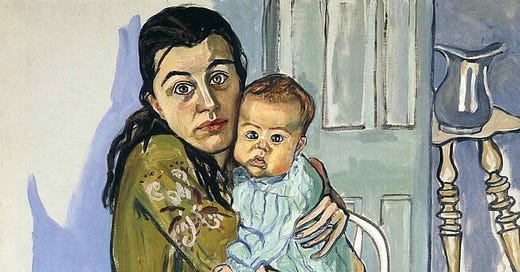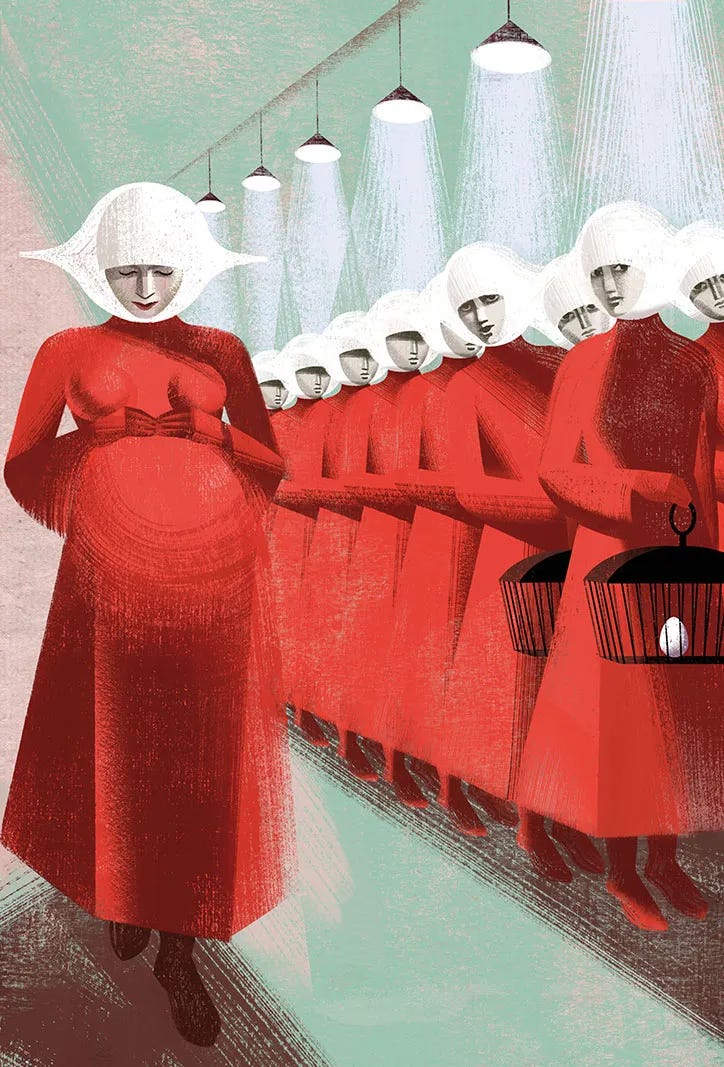24/7 baby machine
ac writes: on the commodification of birth and reproduction, as seen in Margaret Atwood's 'The Handmaid's Tale' and Project 2025
Please Read: This post is not pay-walled. However, if you are so inclined, any funds gained from the day of this post (January 13, 2025) for the next month will be donated to the Arkansas Abortion Support Network. To donate, please consider a paid subscription, leaving a tip, or you can donate yourself. I’ll plan extra (ideally happier) pay-walled posts as well should you subscribe to contribute.
The day after the 2024 election, I began to read the entirety of Project 2025, a document totaling over 900 pages officially titled “Mandate for Leadership: The Conservative Promise.” I’ve linked the PDF here if you have any interest in the form of self-torture that I took part in. Why, AC, would you do this to yourself? (I assume this is what you’re asking). Often, when I am existentially depressed and overwhelmed by the state of the world, I find that I am calmed by the act of research. Twitter and other forms of social media often use hyperbolic tag lines in order to elicit fear, and so by doing my own research directly from the primary sources, I’m able to alleviate that emotion to a certain degree in myself. I wish I could say my fears of what may happen to my body in the next four years were assuaged through this research. They were not.
This endeavor became a much more complex and lengthy task than I had initially anticipated. My initial goal was to break down the entire document on Substack in an attempt to shine light on what the real, verbalized plans were for the new Conservative AmericaTM. About 500 pages in, I was so overwhelmed by the reality of what these theorists and conservative leaders expressed as the “goal” that I couldn’t keep doing it. On my computer, there sits 20+ page document with my notes from only completing a little over HALF of this ‘manifesto’ (?). I couldn’t keep going. The notes, research, and annotated (yes, annotated) PDF have sat untouched on my laptop for the past few months. It has been a much needed reprieve.
It wasn’t until this past week, when I decided to break from the easy-read thrillers that I binged on a snow day to finally dive into Margaret Atwood’s The Handmaid’s Tale (1985), that I remembered my prior endeavor and decided to revisit it. At the risk of sounding like all of the “libbed out” people on the Internet, I’ll admit that I found an important parallel between the vision these writers had for the new conservative America and Atwood’s dystopia: both treat reproduction, and motherhood, as the sole function of women’s bodies. This is not at all to say that I think I’m going to be wearing a red dress and white bonnet in the next four years. I just could not help but notice the similarities in language between the two pieces. Atwood’s is, obviously, a bit more heavy-handed, but when I looked through my notes on Project 2025, parsing out the language used to describe women and policy reforms that impact us, there is a clear emphasis on incentivizing the role of mother and condemning the plight of the Independent Woman. Let’s talk about it.
Author’s Note: I’d also like to just pop in and mention the riot on the Capital in The Handmaid’s Tale, an eerie parallel to the January 6 insurrection.
What I pull from The Handmaid’s Tale to write this piece is the general attitude toward birth and reproduction throughout the novel. The environment has left the birth rate and women’s fertility cripplingly low. Thus, women are forcibly assigned to conceive and reproduce children for the superior class of men (Commanders). Not only does this ‘role’ serve to obviously reduce women to nothing but their wombs, but it works in tandem with a variety of other laws which control and lessen women’s status in this ‘new’ society. Women cannot hold jobs, own money/property, or read and write. Of course, I think we’re a long way off from this being the reality that we face. However, the treatment of conception and the birthing process may not be as far away.
“I cannot avoid seeing, now, the small tattoo on my ankle. Four digits and an eye, a passport in reverse. It’s supposed to guarantee that I will never be able to fade, finally, into another landscape. I am too important, too scarce, for that. I am a national resource.” -Atwood, page 65
All of the proposed policies and reforms that regard women explicitly in Project 2025 have to do, in some form or fashion, with birth. Of course, the most repeated ideology repeated throughout the document is not hard to guess: abortion. In the first section of the piece, Russ Vought writes “The President should immediately revoke Executive Order 1402041 and every policy… produced on behalf of or related to the establishment or promotion of the Gender Policy Council” (62). Now if you, like me, aren’t up to date on the latest Executive Orders, here’s the run down. The policy Vought cites was created by President Biden in 2021 to “ensure that the federal government is working to advance equal rights and opportunities, regardless of gender or gender identity… intended to advance gender equity and equality” (WhiteHouse.gov). Vought believes that revoking this policy would subsequently “eliminate central promotion of abortion (“health services”); comprehensive sexuality education (“education”); and the new woke gender ideology” (62). There is no facade. Access to abortion and reproductive freedoms would be eliminated in the world that Vought (and the handlebar mustache I imagine he has) desires.
In all honesty, though, we cannot be surprised by this. It’s not like abortion hasn’t been severely jeopardized since the Dobbs decision in 2022. What I find interesting, though, are the vast amount of ways that these Project 2025 writers plan to ‘deal with’ blue states which allow for the procedure. Not only should abortion be outright banned by the Department of Health and Human Services (“abortion and euthanasia are not healthcare” on page 450), but there is also a clear goal to “reverse the Biden Administration’s focus on ‘LGBTQ+ equity,’ subsidizing single-motherhood, disincentivizing work, and penalizing marriage,’ replacing such policies with those encouraging marriage, work, motherhood, fatherhood, and nuclear families” (284).
Though the writers concede that all forms of single parenthood should be advocated against to restore these domestic ideals of the nuclear family, it should stand out to you that only single motherhood is explicitly mentioned. Page 451 explicitly mentions that “working fathers are essential to the well-being and development of their children” and the “HHS should prioritize married father engagement in its messaging, health, and welfare policies.” We are given a crystal clear image of what the importance of the woman is: to physically have the children. Motherhood is only encouraged when there is a father (a married father, to be specific) to provide for her and for their offspring. While marriage is not at all necessary for societally approved conception in The Handmaid’s Tale, it goes without saying that reproduction is the primary sole function of women.
I cannot help but think of the words Aunt Lydia speaks to Offred and the other Handmaids in their training:
“You should always try to imagine what [the Wives] must be feeling. Of course they will resent you… You must realize that they are defeated women. They have been unable” -Atwood, page 46
While they are societally ranked higher than the Handmaid’s for their marriage to Commanders, these women are should be “pit[ied]” for their inability to conceive (46).
Furthermore, there is a abject monitoring of women in Atwood’s novel that is not unrepresented in Project 2025. In The Handmaid’s Tale, we have the “Eyes,” who monitor not only women but the entirety of Gilead. In reality… well, we have the “CDC Abortion Surveillance” (455). This was the aspect of Project 2025 that I had heard the most about via social media or the news, that women were going to be watched. As much as I hoped this was another hyperbolic fabrication, it seems to be true. “Because liberal states have now become sanctuaries for abortion tourism, HHS should use every available tool, including the cutting of funds, to ensure that every state reports exactly how many abortions take place within its borders, at what gestational age of the child, for what reason, the mother’s state of residence, and by what method” (455). The mother’s state of residence as a data point should be noted here.
Surveillance also comes on the physician’s side as well. Project 2025 advocates for reforms to HIPAA, removing abortion from patient coverage (“withdraw… HIPAA guidance on abortion” (497)). A national rule such as this would allow for physicians in abortion legal states that have moral issues with the procedure to report patients’ seeking abortion care and, likely, subject them to a bombardment of unwanted information pressuring them to keep their child. Physicians’ will also face possible criminal charges. Should the proposed reversal of the Emergency Medical Treatment and Active Labor Act (EMTALA) proceed as desired by Project 2025, physicians will no longer be federally protected for “perform[ing] abortions in violation of state law if they deem those abortions necessary to stabilize the women’s health” (473). Regardless of the state in which the physician works, Project 2025 proposes banning and ensuring the ban of teaching abortion practices, stating that the HHS should ensure “that training for medical professionals (doctors, nurses, etc.) and doulas is not being used for abortion training” (485). Not only would women run the risk of being tracked across state lines and/or their doctor persecuting them out of a moral disagreement, but they would also face the added struggle of finding physicians who are trained to provide them with the care they need. As an upcoming medical student, I cannot begin to express the heartbreak that this brings me.
We return to Atwood:
“They were doctors, then, in the time before, when such things were legal… They have committed atrocities and must be made into examples, for the rest” - page 32, on the doctors seen by Offred who were executed for performing abortions.
Finally, as if outright banning abortion procedures, revitalizing abstinence-only sex education, monitoring the women who receive abortion care, and emphasizing the prioritization of the father as provider is not enough to convince you that maybe, just maybe, women’s bodies will be reduced to their biologic function, I want to touch on how specifically women’s finances will be impacted and controlled in Project 2025.
At base level, the policies seek to “withdraw appropriated funding, up to and including 10 percent of Medicaid funds, from states that require abortion insurance coverage” (472). But, other policies become much more nuanced (and much scarier) than this. Project 2025 desires to rewrite current policies allowing for insurance-covered contraception by “restor[ing] Trump religious and moral exemptions to the contraceptive mandate” (483). Let’s pause for a brief history lesson brought to us by the Centers for Medicare & Medicaid Services:
“In 2018, final regulations expanded exemptions for religious beliefs and moral convictions allowing private health plans and insurers to exclude coverage of contraceptive services,” the CMS website writes. This allowed for insurance companies to use the vague phrase of “moral convictions” to deny patient’s contraception coverage, a phrase which was removed by the Biden-Harris administration in 2023.
Project 2025 also seeks to “eliminate the week after pill from the contraceptive mandate as a potential abortifacient,” thus completely disallowing any insurance coverage for women seeking emergency contraception (485). They also refer to the week after pill as a “close cousin” of the “abortion pill mifepristone,” which is yet another example of the fear-mongering rhetoric used to perpetuate pro-life ideologies at the expense (in this case, the literal financial expense) of women. For reference, without insurance, the cost of birth control can range, but prices can be up to $268 for the pill to $2004 for the vaginal ring. According to GoodRx, 77% of women on average use their insurance to pay for birth control. One can only wonder how many of us will lose access to contraception should these laws go through.
While we (women) are still able to own our money and spend it how we like, Project 2025 proposes restrictions which will make it exponentially harder to afford reproductive healthcare, thus creating a ripple effect for the financial struggles that women (not to mention the added challenges faced by women of color) will face in this not-so hypothetical future.
Conclusion
As cathartic as it feels to reach the end of this essay and finally close the tab with that horrific PDF, I feel a bit of guilt passing this knowledge on to you. It is infuriating, plain and simple, to see the language used to describe women and their bodies, especially under the guise of “protect[ing] women [and] girls,” as they describe pro-life states to be doing (459).
I also know that I have thrown a lot of quotes and information at you in this piece (sorry about that). But I think it is important that we are aware of what this far-right manifesto plans. I see a world which emphasizes women’s role of giving birth while the husband provides. I see national laws regulating the kind of healthcare I can receive (and one day, as a physician, the kind of care I can provide) and monitoring any attempts I may take to receive that care while making it as financially challenging as possible. To me, that is Atwoodian. By implementing policies which limit the rights of women and prioritize reproduction, we are not humans but a sack of organs meant to carry the next generation. There is a clear desire for the ownership of and control over women’s fertility, thus making pregnancy, birth, and the desire to carry them out a commodity for this far-right ideology. As the U.S. fertility rate continues to decrease, it is worth considering what the implications may be for our future.
I have tried to be as non-hyperbolic as possible throughout this essay, providing you with quotes from both Atwood and Project 2025 and merely… noticing… the similarities in their over arching rhetoric. It is with the utmost sincerity that I say I hope that I am wrong, that these policies don’t come to fruition and somehow, someway, we can change it. But, until we know for sure, all we can do is help who we can where we can… and maybe stock up on our birth control. I’ll leave you with this:
“I used to think of my body as an instrument, of pleasure, or a means of transportation, or an implement for the accomplishment of my will. I could use it to run, push buttons of one sort or another, make things happen. There were limits, but my body was nevertheless lithe, single, solid, one with me. Now the flesh arranges itself differently. I’m a cloud, congealed around a central object, the shape of a pear, which is hard and more real than I am and glows red within its translucent wrapping.” -Atwood, page 73
All Sources Used Throughout This Piece Have Been Linked Where Relevant.











such a great analysis on project 2025 and its implications on reproductive rights—kudos to you for tackling that beast of a document, and for bringing a fresh take to the Handmaid’s Tale analogy! I lol’ed at “libbing out” and Vought’s handlebar mustache, lmao
glad to know we’ve got people like you who care about reproductive justice going into the healthcare field!!
This is such a great analysis on what's going on ur so eloquent and well researched and smart it's not easy to tackle but the first step is saying what's going on and writing about it and defining it so at least it's recorded wish u all the best going into healthcare stay strong keep writing